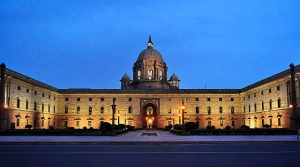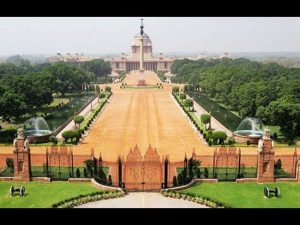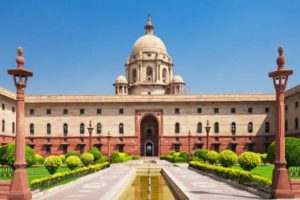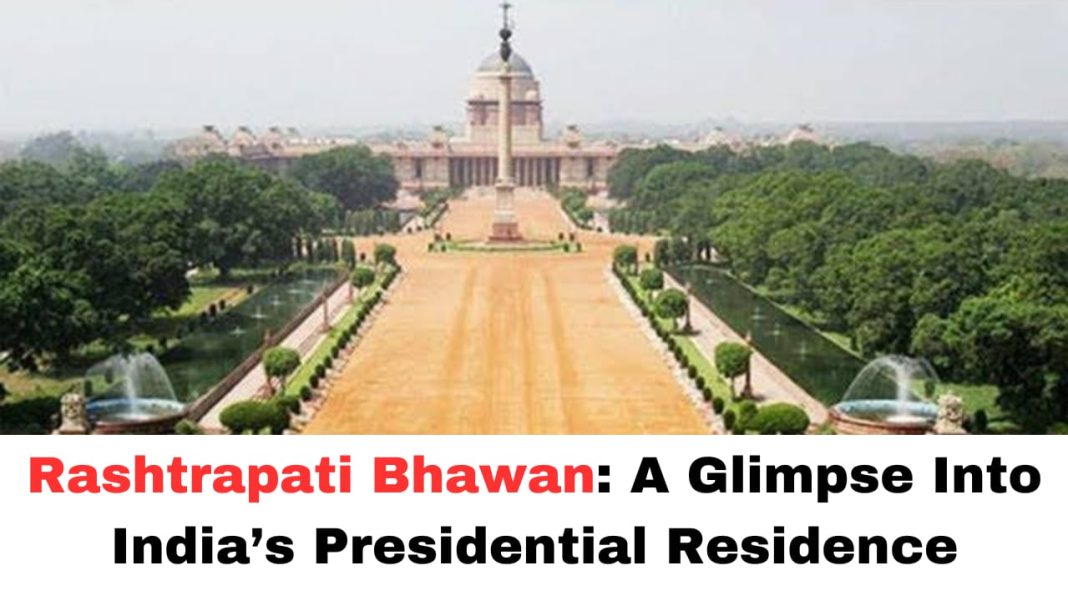Digital News Guru New Delhi Desk:
Rashtrapati Bhavan: The Presidential Palace of India
Rashtrapati Bhawan, located in the heart of New Delhi, is one of the most iconic buildings in India, symbolizing the power, authority, and grandeur of the Indian Republic. It serves as the official residence of the President of India and is a blend of architectural excellence, historical significance, and cultural heritage. This majestic building not only houses the office and residence of the President but also stands as a symbol of India’s democratic ethos and its colonial past.
Historical Background
Rashtrapati Bhawan was originally designed as the Viceroy’s House during British rule in India. The idea of building a grand palace in New Delhi was conceived by the British Empire as part of the grand plan to establish New Delhi as the new capital of India, replacing Calcutta (now Kolkata). In 1911, during the reign of King George V, the British decided to move the capital from Calcutta to New Delhi. The decision was part of a larger vision to create a city that would reflect the power and glory of the British Empire.

The construction of the Viceroy’s House began in 1912 and was completed in 1929. The British architect Sir Edwin Lutyens, who played a pivotal role in designing New Delhi, was tasked with designing the Viceroy’s House. His design was intended to reflect both the British imperial style and Indian architectural traditions, creating a blend that would symbolize the fusion of East and West.
The building served as the official residence of the Viceroy of India, the representative of the British Crown, until India gained independence in 1947. After independence, the Viceroy’s House was renamed Rashtrapati Bhawan and became the residence of the President of India.
Architectural Design and Layout
Rashtrapati Bhawan is a magnificent blend of Western and Indian architectural styles. The building was designed by Sir Edwin Lutyens and Herbert Baker, two renowned British architects, with Lutyens taking the lead in its conceptualization. The architecture reflects a blend of classical Greco-Roman styles, such as the use of columns and domes, with traditional Indian elements like the use of chhatris (elevated, dome-shaped pavilions) and intricate carvings.
The main building of Rashtrapati Bhawan has 340 rooms, and its layout is symmetrical, with its central dome being the most distinctive feature. The dome, which is 30 meters in diameter, is inspired by the great Buddhist stupas of India, particularly the Sanchi Stupa. The structure is built in such a way that it gives the illusion of being larger from certain angles, highlighting its majestic presence. The building is made of local sandstone, which gives it a warm and regal appearance.
The Rashtrapati Bhawan is situated at the end of Rajpath, the ceremonial avenue that stretches from India Gate to Rashtrapati Bhawan, and it forms the focal point of New Delhi’s central vista. The grandeur of the building is enhanced by its expansive gardens, which are spread over 330 acres, making it one of the largest presidential estates in the world.
The Mughal Gardens
One of the most beautiful aspects of Rashtrapati Bhawan is its Mughal Gardens, located to the south of the building. These gardens are an example of the traditional Mughal style of landscaping, which incorporates symmetrical layouts, geometric patterns, and the use of water elements. The Mughal Gardens are particularly famous for their vibrant flowers, lush greenery, and water channels, which are designed to create a serene and peaceful environment.

The gardens are open to the public during the annual Udyanotsav (garden festival) in spring, allowing visitors to experience the beauty and tranquility of the gardens. During this time, people from all walks of life are given the opportunity to visit and appreciate the pristine beauty of the garden’s layout and the different varieties of flowers that bloom there.
Functions and Significance
As the official residence of the President of India, Rashtrapati Bhawan is the epicenter of ceremonial and state functions. It serves as the venue for key events such as the President’s Address to the Nation, Republic Day celebrations, and the swearing-in ceremony of the new President. The building is also used to host foreign dignitaries, with state banquets and meetings often taking place within its walls.
The President of India, as the ceremonial head of state, performs a variety of duties, such as appointing the Prime Minister, overseeing the functioning of the executive branch, and representing India at the international level. While the President’s powers are largely ceremonial, the building itself holds immense symbolic importance in Indian governance.
The Rashtrapati Bhavan Museum Complex
In addition to its role as the official residence of the President, Rashtrapati Bhawan also houses a museum that showcases the history of India’s presidency and the architectural and cultural heritage of the building. The Rashtrapati Bhawan Museum Complex is located in the former presidential stables and includes a variety of exhibits, including artifacts, photographs, and gifts given to Indian presidents. Visitors can also learn about the history of Rashtrapati Bhawan, its architecture, and the various important events that have occurred within its walls.
One of the main attractions of the museum is the collection of President’s gifts, which includes items presented to the President by foreign heads of state, along with items related to the evolution of Indian democracy and governance.
Security and Access
Rashtrapati Bhawan is one of the most secure buildings in India, with tight security protocols in place to ensure the safety of the President and the residents of the building. The building is heavily guarded by the Central Reserve Police Force (CRPF) and other specialized security agencies. Access to the building is strictly regulated, with visits generally restricted to official functions, ceremonies, and events.

However, parts of the estate, including the Mughal Gardens, are open to the public during specific times of the year, allowing people to experience the beauty and majesty of this historic monument.
Conclusion
Rashtrapati Bhawan is not just the residence of the President of India; it is a symbol of India’s democracy, its architectural splendor, and its colonial past. It stands as a reminder of India’s journey from British colonial rule to a sovereign democratic republic. Its blend of Indian and Western architectural elements makes it a unique building that is admired by people from across the world.
Today, Rashtrapati Bhawan continues to be an integral part of India’s political and cultural landscape, hosting state functions, representing the values of the Indian republic, and welcoming visitors from around the globe. It is a true testament to India’s rich history and the enduring spirit of its people.
You May Also Read: Epigamia CEO Rohan Mirchandani Passes Away at 42 due to Cardiac Arrest








